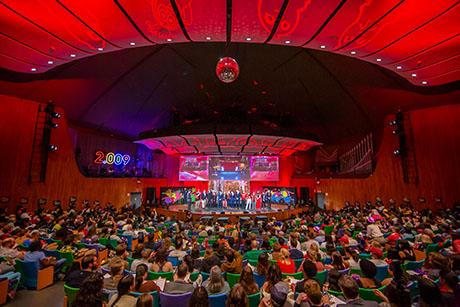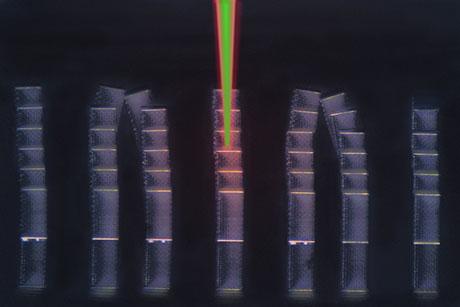Talking Shop: Kripa Varanasi
Talking Shop with Associate Professor Kripa Varanasi
Thinking Outside the Box Leads to Surface Innovations
By Alissa Mallinson

Photo credit: Tony Pulsone
Associate Professor Kripa Varanasi’s research lab became a sudden media sensation this past year when it unveiled its condiment bottle coating LiquiGlide. A nontoxic, nonstick, super slippery coating made from food-grade materials, LiquiGlide solved a long-time problem that many people can relate to: the struggle to expel a condiment like ketchup, mustard or mayonnaise from its bottle.
Varanasi (PhD ’04) and Dave Smith (SM ’11), two of LiquiGlide’s inventors, recently incorporated around the product. With Smith as CEO and Varanasi as science advisor, the two have plans to expand the coating into several other industries in the future.
What research was your lab working on when LiquiGlide was developed?
We were looking at making surfaces that can overcome existing super hydrophobic surface issues, such as those that accompany impact and phase transitions. That got me thinking about nanostructures. What if you made a surface with a texture that is impregnated with liquid? Instead of trapping air pockets, which is what super hydrophobicity is based on, you have a liquid pocket, which is more stable due to capillarity. If a water droplet impacts an air-pocket-based super hydrophobic surface forcefully, it’s going to impale and you lose the nonwetting effect. But with our new method, there’s no way to displace the liquid without going to very high velocities. And water cannot condense within these textures either – similarly with frost. When I came to MIT as an assistant professor in 2009, Dave Smith was one of my first students. I discussed this with him and we thought it could be a really interesting thing to look at.
We were both very interested in commercialization and debated the best application for this discovery. Meanwhile, we learned about the problem of dispensing product from bottles. It’s something the whole consumer packaging industry struggles with, not only out of bottles but also out of production vats. Some companies lose up to 20% of their product during this process. So we started looking at condiment bottles. We never expected it to become the phenomenon that it did.
It was a bit serendipitous then?
Yes, consumer packaged goods (CPGs) was not on my research agenda [laughs]. But once we started applying the coating to the CPG industry – triggering our participation in the MIT $100K Competition and the subsequent media frenzy over LiquiGlide – we realized that it’s a great place to start because its commercialization time is very quick.
We also came to the idea that the coating can be applied to health and beauty products too, which is an even bigger market. LiquiGlide is a solid-liquid coating, which means it can be applied to many different products but that each needs its own combination of materials. It’s a new paradigm of coatings. We have all the rules and recipes to adjust the coating as necessary. The science of that is captured in a phase diagram. Our goal with LiquiGlide is to apply it to many different industries. We plan to have a CPG division, an aviation division, an energy division, a health and beauty division, and so on.
What is it about the commercialization process that appeals to you?
I am driven to take the science and technologies we develop in the lab to practice. I believe that surface technologies can be useful in improving efficiencies in many areas, whether it be energy, water, or consumer packing. I want to see this research go in and deliver the benefits to sponsors and the general population. I have tried to instill this idea in many of my group members. Dave took it to heart.
In my group, we patent a lot. We have had more than 20 patents since I started my lab. MIT is a great place for innovation and commercialization. The entrepreneurial ecosystem here is excellent; we have received help and support from so many places, including some of my colleagues; The Deshpande Center; Bill Aulet, managing director of the Martin Trust Center for MIT Entrepreneurship; Venture Mentoring Services; Technology Licensing Office; and many more. The whole network at MIT is very electric in terms of getting your ideas out there and potentially commercializing them. For me, I don’t think this is the last startup I will be part of. I think we will have many more.
So you really enjoy the process?
I love it. It’s so thrilling. I’m always interested in learning new things, and this was quite an experience in those terms – learning how to talk to lawyers, how to find a lab space, how to raise money, and so on.
Do you have a secret ingredient for innovation?
I think curiosity is probably the most important thing. The second is having a varied background of knowledge and experience. You start to see that you can apply ideas from one realm of science in another. I did work in thermal-fluids, precision engineering, nanofabrication, solid-state physics, electromagnetism, et cetera. All of that was driven by the curiosity to learn new things. I cannot stop thinking about new projects and new ideas. It’s like a drug for me. I tell all my students and group members that you can be entrepreneurial in many ways; it doesn’t have to be through commercialization. You could be entrepreneurial in the research that you’re doing, for example. I always like to think about solving a problem in a way that might seem counterintuitive, to potentially create something that you wouldn’t think could happen to give you a big jump in the ultimate performance.
Professor Varanasi is recognized as an emerging leader at the crossroads of thermal sciences, nanotechnology, and manufacturing. The principal theme of his research is the discovery and development of novel nano-engineered surfaces and coating technologies that can fundamentally alter thermal-fluid-interfacial interactions for transformational efficiency enhancements in various industries, including energy, water, agriculture, transportation, electronics cooling, and buildings.
His work has been recognized with an NSF CAREER Award as well as by a DARPA Young Faculty Award. Time magazine and Forbes magazine have named his lab’s invention LiquiGlide one of the Best Inventions of the Year. He was most recently awarded the 2013 Outstanding Young Manufacturing Engineer award by the Society of Manufacturing Engineers. Professor Varanasi is also noted for his teaching in the core undergraduate design, mechanics, and thermal sciences courses.


